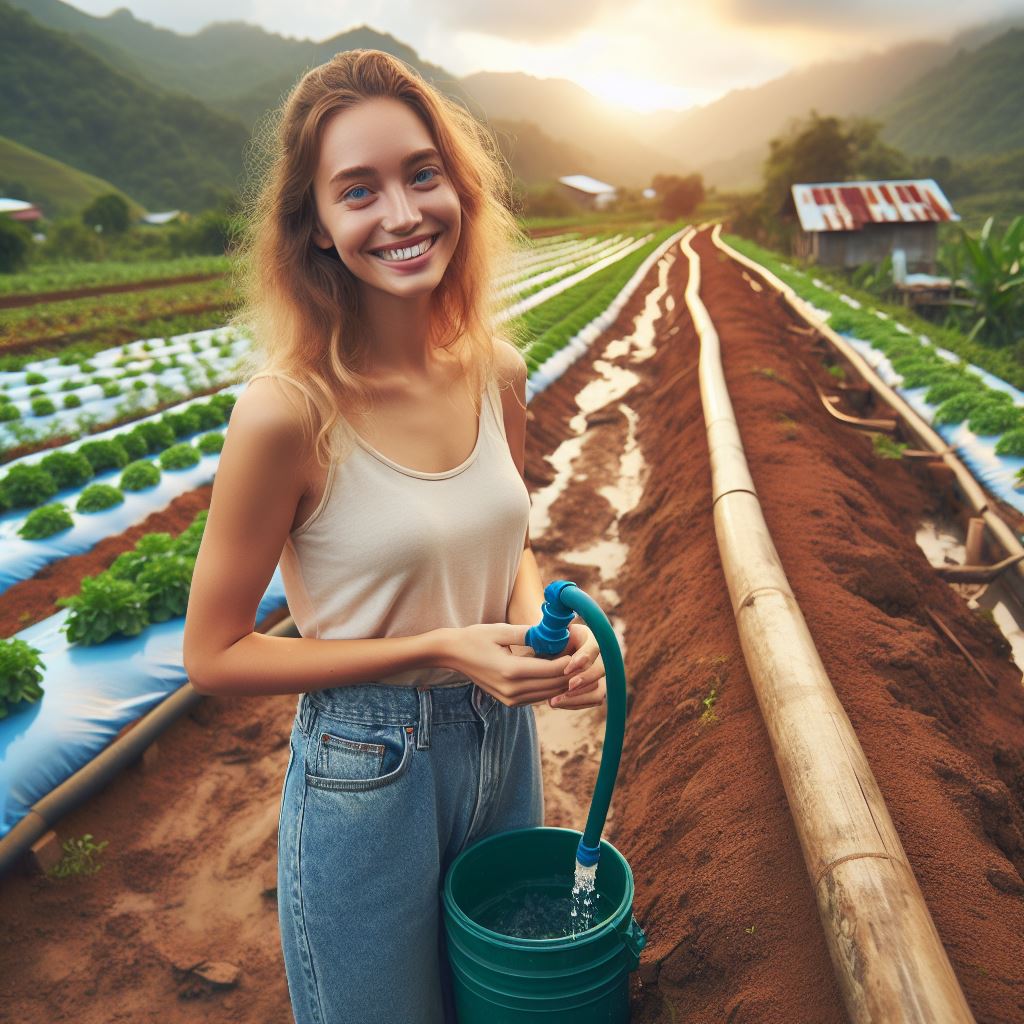Introduction
Rainwater harvesting is a method of collecting, storing, and using rainwater for various purposes.
It involves the capture and storage of rainwater from rooftops, land surfaces, or underground structures before it reaches the ground.
This water can then be used for irrigation, livestock watering, and even household purposes.
Sustainable farming plays a vital role in ensuring a healthier and more environmentally friendly approach to agriculture.
It focuses on minimizing the use of non-renewable resources and harmful chemicals, while maximizing the efficient use of natural resources like water.
By implementing rainwater harvesting techniques, farmers can enhance the sustainability of their farms.
Rainwater harvesting benefits sustainable farming in several ways.
Firstly, it provides an alternative water source for irrigation, reducing the reliance on groundwater and surface water sources.
It helps to conserve water resources and ensures their availability in arid regions or during droughts.
Furthermore, rainwater harvesting reduces soil erosion and runoff, preventing the loss of valuable topsoil and essential nutrients.
By using stored rainwater, farmers have greater control over their irrigation practices, leading to improved crop yields and water efficiency.
In addition, rainwater harvesting is cost-effective for farmers as it reduces the need for expensive water sources and infrastructure.
It promotes self-sufficiency and resilience, ensuring farms can sustainably produce food even in water-stressed areas.
Overall, rainwater harvesting is a powerful tool that bolsters sustainable farming practices.
It mitigates water scarcity, conserves resources, enhances soil health, and improves yields.
By implementing such techniques, farmers can contribute to a more sustainable and resilient agricultural system, ensuring food security for generations to come.
Benefits of Rainwater Harvesting for Sustainable Farms
Conservation of water resources
- Rainwater harvesting helps in conserving precious water resources for sustainable farming practices.
- By collecting and storing rainwater, farmers can reduce their dependence on scarce water supplies.
- This ensures a reliable and sufficient water source for irrigation, livestock, and other agricultural needs.
Reduction in irrigation costs
- Rainwater harvesting systems can significantly reduce the need for expensive irrigation techniques.
- Using harvested rainwater for irrigation can save farmers money on water bills and pumping costs.
- It provides a cost-effective solution for sustaining agricultural productivity in water-scarce regions.
Protection against drought
- Rainwater harvesting acts as an effective coping mechanism during periods of drought.
- Stored rainwater can be used to supplement water requirements, ensuring crop survival during dry spells.
- It helps farmers mitigate the impacts of climate change and build resilience in agricultural production.
Reducing soil erosion and water runoff
- Rainwater harvesting systems prevent soil erosion caused by excessive water runoff.
- By capturing rainwater, it allows the water to infiltrate the soil, reducing the risk of erosion.
- This helps in maintaining soil fertility and preventing the loss of valuable topsoil.
In general, rainwater harvesting offers numerous benefits for sustainable farming practices:
- It conserves water resources, reducing the reliance on scarce water supplies.
- By reducing irrigation costs, it provides a cost-effective solution for farmers.
- During drought periods, it ensures crop survival and builds resilience in agriculture.
- It also helps in reducing soil erosion and the loss of valuable topsoil.
Implementing rainwater harvesting systems can contribute to sustainable farming practices, enhancing food security and environmental sustainability.
Read: Future of Farming: Climate Adaptations
Methods of Rainwater Harvesting for Sustainable Farms
Rainwater harvesting is a crucial practice for sustainable farms as it helps to conserve water and improve agricultural productivity.
There are various methods that farmers can employ to harvest rainwater effectively.
In this section, we will explore some of the most popular techniques used by farmers for rainwater harvesting on sustainable farms.
Rain barrels
One of the simplest and cost-effective methods of rainwater harvesting is through the use of rain barrels.
These are large containers that collect rainwater from rooftops and store it for later use.
The collected water can be used for irrigation, livestock watering, or other non-potable purposes.
Rainwater collection systems
Rainwater collection systems are more advanced than rain barrels and can collect larger quantities of rainwater.
These systems consist of gutters and downspouts that direct the rainwater into storage tanks or underground cisterns.
The collected water can then be filtered and used for various farm activities.
Rooftop harvesting
Rooftop harvesting involves directing rainwater that falls on the roofs of farm buildings into storage tanks or reservoirs.
Farmers can install gutters and pipes to collect the rainwater and direct it to a central storage system.
This method efficiently utilizes the vast surface area of roofs for rainwater collection.
Permeable pavement
Permeable pavement is a sustainable technique that allows rainwater to infiltrate through the ground rather than running off.
By using permeable or porous materials for pathways, farm driveways, or parking areas, rainwater can seep into the soil, replenishing the groundwater table.
This method also reduces the risk of soil erosion and improves water quality.
These methods of rainwater harvesting offer several benefits for sustainable farms.
Firstly, they reduce the reliance on groundwater sources for irrigation, thereby conserving precious water resources.
Secondly, harvested rainwater is free from chemicals, making it a safe and cost-effective alternative for farm activities.
Moreover, rainwater harvesting helps mitigate the risk of flooding by capturing and storing excess rainfall.
Transform Your Agribusiness
Unlock your farm's potential with expert advice tailored to your needs. Get actionable steps that drive real results.
Get StartedWhen implementing rainwater harvesting methods, farmers should consider some essential factors.
Firstly, proper maintenance of collection systems is crucial to ensure the quality of harvested rainwater.
Regular cleaning and inspection of gutters, filters, and storage tanks will prevent contamination.
Furthermore, farmers should consider the size and capacity of the harvesting systems based on their water needs and geographic location.
It is also important for farmers to educate themselves about local regulations and permits required for rainwater harvesting.
Some areas may have restrictions or guidelines in place, particularly when it comes to using rainwater for potable purposes.
By complying with these regulations and seeking necessary approvals, farmers can ensure the sustainability and legality of their rainwater harvesting practices.
In short, rainwater harvesting is a valuable practice that contributes to the sustainability of farms.
By utilizing methods such as rain barrels, rainwater collection systems, rooftop harvesting, and permeable pavement, farmers can conserve water, improve agricultural productivity, and reduce the strain on groundwater sources.
However, proper maintenance, awareness of regulations, and considering specific farm needs are essential for successful rainwater harvesting.
Implementing these methods will not only benefit individual farms but also contribute to the overall goal of creating a more sustainable and resilient agricultural sector.
Read: Drought and Its Economic Impact on Farms
Implementing Rainwater Harvesting on Farms
Assessing water needs and availability
- Determine the water requirements of the farm by considering crop types, irrigation systems, and livestock.
- Evaluate the availability and quality of existing water sources such as wells, rivers, or ponds.
- Measure rainfall patterns in the region to determine the amount of water that can be harvested.
Designing and building rainwater harvesting systems
- Select an appropriate system based on the farm’s needs and available resources, such as rooftop collection or surface runoff collection.
- Calculate the size of storage tanks required to ensure enough water supply during dry periods.
- Design a filtration system to remove debris and improve the water quality for irrigation and other uses.
- Install gutters, pipes, and valves to channel rainwater from rooftops or surfaces to the storage tanks.
- Construct a secure and durable storage facility to prevent contamination and ensure long-term functionality.
- Consider incorporating additional technologies like runoff diversion trenches or check dams to optimize water capture.
Maintenance and regular inspections of the systems
- Create a maintenance schedule to regularly clean and inspect all components of the rainwater harvesting system.
- Clear gutters, screens, and filters to prevent blockages and ensure efficient water collection.
- Check for leaks or damages in pipes, tanks, and other infrastructure, repairing or replacing as necessary.
- Regularly monitor water quality to ensure it remains safe for both agricultural and domestic use.
- Periodically test the system’s efficiency by comparing expected versus actual water collection and usage.
- Educate farm workers on the importance of proper system maintenance and provide training on troubleshooting common issues.
- Keep records of maintenance activities, repairs, and any improvements made to the rainwater harvesting system.
In fact, implementing rainwater harvesting on farms requires a systematic approach.
Assessing water needs and availability is crucial to determine the feasibility of such systems.
Designing and building the appropriate infrastructure ensures efficient rainwater collection and storage.
Regular maintenance and inspections are essential to keep the system functional and optimize water use.
By adopting rainwater harvesting, farms can increase their sustainability and resilience in the face of water scarcity and climate change.
Read: Climate-Smart Farming: A Global Overview

Success Stories of Rainwater Harvesting on Sustainable Farms
Specific farms that have implemented rainwater harvesting
- Smith’s Organic Farm in California
- Green Acres Farm in Texas
- Harvest Fields Farm in Oregon
Their experiences and results
1. Smith’s Organic Farm in California
Smith’s Organic Farm, located in California’s drought-prone region, implemented rainwater harvesting as a sustainable solution.
They installed large rooftop collection systems and storage tanks.
The farm reported a significant reduction in reliance on municipal water supplies and savings on water bills.
The stored rainwater proved crucial during dry seasons, ensuring the continuous cultivation and irrigation of crops.
Rainwater harvesting transformed Smith’s Organic Farm into a water-independent and self-sufficient operation, contributing to its overall sustainability and profitability.
2. Green Acres Farm in Texas
Green Acres Farm, situated in Texas where water scarcity is a prevalent issue, embraced rainwater harvesting to combat agricultural challenges.
They utilized a combination of techniques such as contour farming, swales, and infiltration basins to capture rainwater effectively.
This allowed them to replenish groundwater and provide sustainable irrigation for their crops.
As a result, Green Acres Farm witnessed increased crop yields, improved soil quality, and reduced dependence on traditional water sources.
They even managed to reduce their environmental impact by conserving water resources.
3. Harvest Fields Farm in Oregon
Harvest Fields Farm, located in a region known for heavy rainfall, implemented rainwater harvesting systems to harness the abundance of precipitation.
They constructed large-scale rainwater collection ponds and implemented an efficient distribution network to optimize water usage in their irrigation systems.
The farm benefited from reduced erosion, improved soil health, and increased water retention capacity.
They also utilized the stored rainwater for sustainable livestock management.
Harvest Fields Farm stands as a successful example of rainwater harvesting, optimizing the farm’s irrigation and water management practices.
These success stories exemplify the positive impact of rainwater harvesting on sustainable farms.
By adopting this practice, farms can mitigate water scarcity, reduce environmental impact, and enhance their overall resilience.
Through the implementation of innovative techniques and infrastructure, farms like Smith’s Organic Farm, Green Acres Farm, and Harvest Fields Farm have achieved self-sufficiency and sustainability.
As more farms adopt rainwater harvesting, the agricultural sector can contribute to water conservation, climate change mitigation, and the development of a more sustainable future.
Read: Livestock Farming: Adapting to Climate Shifts
Challenges and Solutions for Rainwater Harvesting on Farms
Limitations of rainwater harvesting
Rainwater harvesting on farms faces several challenges that need to be addressed for its successful implementation.
- Limited water storage capacity: One of the major limitations of rainwater harvesting is the limited amount of water that can be stored. This is particularly a concern in areas with low rainfall or erratic precipitation patterns.
- Contamination risks: Rainwater can get contaminated with various pollutants such as chemicals, pesticides, and bacteria. These contaminants pose a threat to both livestock and crops, affecting the overall productivity and sustainability of the farm.
- Dependence on unpredictable weather: Rainwater harvesting heavily relies on rainfall, making it vulnerable to unpredictable weather conditions. Droughts, floods, or prolonged dry spells can disrupt the availability of water, hampering the farming operations.
Overcoming challenges such as limited space and weather conditions
Despite the challenges, there are solutions available to overcome the limitations of rainwater harvesting on farms.
- Improved storage systems: Implementing larger storage systems like ponds, tanks, or underground cisterns can increase the water-holding capacity of the farm. This allows for better utilization of rainfall during periods of low precipitation.
- Water treatment technologies: Various filtration and purification technologies can be employed to remove contaminants from harvested rainwater. These technologies ensure the quality of water for agricultural use and minimize the risk of crop and livestock contamination.
- Diversification of water sources: Instead of relying solely on rainwater harvesting, farms can explore alternative water sources such as borewells, lakes, or rivers. This diversification helps mitigate the risks associated with unpredictable weather patterns and ensures a more consistent water supply.
Innovations and technology advancements
Advancements in technology have led to the development of innovative solutions for rainwater harvesting on farms.
- Smart irrigation systems: Automated irrigation systems that utilize sensors and weather forecasting data can optimize water usage based on real-time conditions. These systems prevent overwatering and can be integrated with rainwater storage tanks for efficient water management.
- Rainwater collection roofs: Specially designed roofs with channels and guttering systems efficiently collect rainwater from large surface areas such as barns or sheds. This harvested water can then be directed to storage tanks for future use.
- Cloud seeding: In areas with low rainfall, cloud seeding technology can be employed to enhance rainfall by dispersing substances into clouds that stimulate precipitation. This method can help increase water availability for rainwater harvesting on farms in drought-prone regions.
In review, while rainwater harvesting on farms may face limitations, there are solutions available to overcome these challenges.
Through improved storage systems, water treatment technologies, diversification of water sources, and innovative advancements, farms can harness rainwater effectively for sustainable agricultural practices.
Embracing these solutions will not only ensure water security but also contribute to the overall sustainability of farms in the long run.
Showcase Your Farming Business
Publish your professional farming services profile on our blog for a one-time fee of $200 and reach a dedicated audience of farmers and agribusiness owners.
Publish Your ProfileConclusion
Recap the benefits of rainwater harvesting for sustainable farms
Rainwater harvesting provides numerous benefits for sustainable farms.
It helps conserve water resources, reduces dependence on groundwater, and minimizes soil erosion.
Additionally, it helps improve soil fertility, reduces chemical runoff, and promotes biodiversity on farms.
Wider adoption of rainwater harvesting practices in farming
It is crucial to encourage and promote the wider adoption of rainwater harvesting practices in farming.
By doing so, farmers can reduce their reliance on traditional water sources and become more self-sufficient.
This will not only benefit their farms but also contribute to the sustainable management of water resources on a larger scale.
Final thoughts on the importance of sustainable practices
Sustainable practices, such as rainwater harvesting, play a vital role in ensuring the long-term viability of agriculture.
They help mitigate the impacts of climate change, preserve natural resources, and protect ecosystems.
By embracing sustainable farming methods, we can create a more resilient and environmentally friendly agricultural sector, ensuring food security for future generations.
It is crucial for policymakers, farmers, and consumers to recognize the importance of these practices and actively support their implementation.
Together, we can build a more sustainable future for agriculture.




